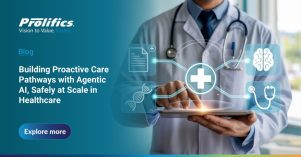Blog by Swati Dora, Prolifics Associate Client Success Leader
After a hectic day at work, I wanted to watch “Tom and Jerry” reruns. I searched YouTube but couldn’t find the episodes that I liked. I remembered that I have a few episodes saved in my laptop. But I wanted to see it on a bigger screen after working all day on a laptop. So, I connected my laptop to the TV using a cable. I laughed my heart out and had a perfect break.
Let’s think back on what we do regularly, and how we need data and devices connected. This is “integration.” Integration solves the problem of connecting systems together so that you don’t have to store and access the same data in various locations. As a result, you can have numerous options on the interconnected systems.
Change is a constant. As and when your business needs change, you will need to plug in data from third parties or different sources to achieve a wider range of tasks in your single application. Integration is essential for virtually all enterprises to thrive. The range of integrations varies by the purpose (content, analytics) and the integration solution can solve a simple need or tie off varied complex components of the business. To connect back to the daily life analogy, without integration I couldn’t have connected my laptop to the TV to watch my favorite cartoon.
The government has announced $13 billion in financial opportunities for expansion and modernization of the nation’s electric grid – “Building a Better Grid Initiative.” Coming back to the need for integration in energy and utility (E&U) modernization, we need it for accessing data related to customers, metering, billing, weather, geospatial, outages, grid, legacy applications, drive analytics, dashboard and so on.
Some emerging E&U trends:
Integrating Distributed Energy Resources (DER) – The majority of the E&U players have pledged to a carbon-free footprint by 2050 to reduce the effects of climate change. The government is also paying subsidies to install solar panels as a renewable source of energy. To improve service reliability and reduce hazards, E&U is also supporting remote grids. While all these solve the core problem of generating electricity efficiently, we would still need to fulfill several other customer requirements such as tracking their energy usage, connecting these DERs to the main grid and existing applications.
Real-time energy usage – Both consumers and producers can benefit tremendously from insightful near real-time usage data. With distributed energy resources and ADMS, producers can use the data to predict usage patterns and generate appropriately. Consumers can choose to switch appliances on and off, using them at low demand times to enjoy lower rates. Batteries can be used for storing power and used as back-up during adversities.
Demand forecasting – With advanced metering infrastructure (AMI) and electric vehicles (EVs) on the rise, E&U companies will have huge amounts of data coming in. Appropriate artificial intelligence / machine learning (AI/ML) models can help these companies build efficient operational engines that powers their integration, analytics and monitoring dashboards. They can use this data, in addition with weather data, to forecast unplanned outages, sudden surges on the grid during peak hours, and thereby plan generation better.
Industrial metaverse – Asset, system and customer engagement can see maximum reaped benefits by adopting building blocks of the metaverse, such as digital twins, augmented reality and artificial intelligence. Think about the benefits the industry can reap while predicting the asset maintenance or planned generation capacities by intertwining the real-time data from sensors on assets with digital twins. It’s the near future!
What integration products are available?
Depending on your intent and your information type, there are various product suites available in the market to choose from. Some of the product suites that I have implemented in my experience are:
- IBM MQ, ACE: Simplicity, speed, and extensive connectors are a few of its great values. The out-of-the-box (OOB) specs would cover most needs. It is one of the best tools for using an enterprise service bus (ESB) in a large-scale company.
- Salesforce MuleSoft Anypoint Platform: It has one of the best “marketecture.” It is robust, configurable and scalable.
- Informatica IICS: It helped to communicate and integrate different applications and databases very seamlessly. It fit really well as an orchestration platform.
- A few other suites that I have come across are Seeburger BIS, TIBCO Cloud Integration, Oracle Service Bus. Each of these products comes with its own flavors of features and pricing.
How would E&U companies benefit from modernizing integration?
- Drive innovation: Integration helps stitch data across your enterprise and gives you valuable insight. A single stage view will drive a lot of use cases for forecasting maintenance of assets, predicting generation, and aiding a customer-centric journey.
- Fast to market: In today’s generation, a company thrives when it’s able to adapt to rapidly changing patterns of consumer behaviors. Integration helps in building backbone for the plug and play of the required information.
- Improve key performance indicators (KPIs): Whether it’s the “Customer Average Interruption Duration Index,” “System Average Interruption Duration Index,” or “Asset Utilization,” each of these indices plays a very important role in the health of the E&U industry. Integration plays a core role in not only calculating these indices but also provides a segue to use the data – with AI/ML – to break the barriers associated with energy generation, transmission and distribution.
Let’s unlock the potential of all your applications by integrating them and building a strong product by bringing in the best from each. My favorite quotes from Steve Jobs sums it all perfectly: “Our method was to develop integrated products, and that meant our process had to be integrated and collaborative.”
Read Swati’s other blogs:




